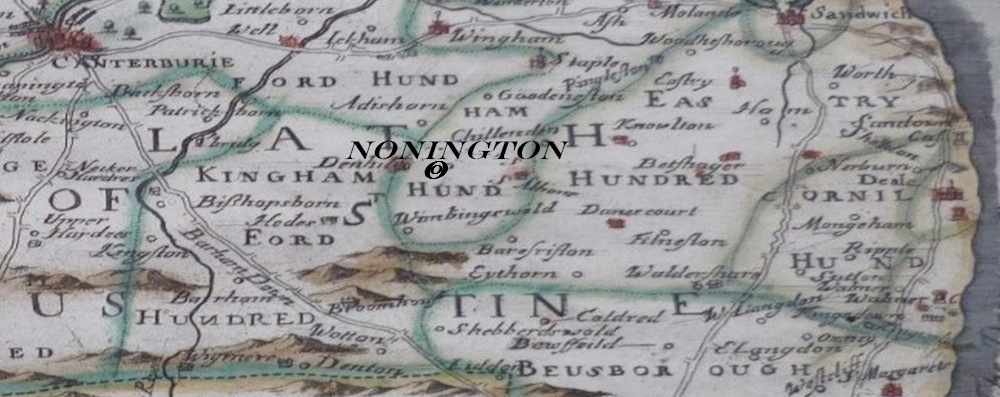
Nonington, an extract from Philip Lea’s “New Map of Kent”, c 1690
The old parish of Nonington was some three miles across in each direction with St. Mary’s Church roughly at its centre with the hamlet of Nonington proper surrounding the church. A survey made for Archbishop Lanfranc in the early 1070’s refers to “Nunningitun” church as a subsidiary of “the mother church” at Wingham, this appears to be the earliest reference to Nonington. The settlement evolved on a cross-roads formed by a direct route to Christ Church in Canterbury via Ratling, Adisham, Bekesbourne and St. Martin’s Hill, and the road from Chillenden and Rolling through Nonington to Womenswold and beyond.
The parish church probably has its origins in an estate known as Oeswalum. From the 780’s the estate was owned by the Abbess of Minster and Suthminster Abbeys but by the 820’s the ownership of Oeswalum was disputed between Abbess Cwoenthryth, the daughter of Coenwulf, the king of Mercia and Archbishop Wulfred of Canterbury The dispute was settled in Wulfred’s favour and after Wulfred’s death Oeswalum was inherited by his kinsman, Werhard, who in turn left it to Christ Church Abbey in Canterbury and Oeswalum subsequently absorbed into the Manor of Wingham which was held directly by the Archbishops of Canterbury.
Some three quarters of a mile to the north-east of the church along the old way to Chillenden was the small estate of Monkton, the Monks farm, part of the Manor of Adisham given to Christ Church in Canterbury in 616 and now called Gooseberry Hall farm.
Monkton also stands on a cross-roads, this one formed by the old roughly south to north Nonington to Chillenden way and an ancient roughly west to east track-way or “pilgrim’s road” running from Canterbury through Bekesbourne, Bossingham, near Adisham, through the present Goodnestone Park and then along the present Cherry Garden Lane on the north-eastern boundary of Nonington parish and on towards Eythorne and beyond.
It’s therefore very possible that the appellations of Nunningitun and Monkton evolved to differentiate between the land held by “the Nuns” of Suthminster and “ the Monks” of Christ Church.
The Chapel of Nunningitun was a chapel of ease of its mother church at Wingham and recorded as such in a list of parish churches compiled for Archbishop Lanfranc soon after his appointment in 1070. It stood on land belonging to the Manor of Wingham which in turn was part of the Archbishop of Canterbury’s holdings.
Nonington was one of four parishes created from the formation in 1282 of the College of Wingham from the Manor of Wingham by Archbishop Pecham. ‘The Chronicles of Wingham’ by Arthur Husseygive the following description of the College’s origins. “On August 2nd 1282 Archbishop John Peckham founded the College of Wingham, a college of secular canons consisting of a provost and six canons, divided into four parishes as follows: Wingham; Esse (Ash); Godwyneston (Goodnestone) with the hamlets of Bonnington, Offington (Uffington in Goodnestone parish), Rolling, Newenham, underdone together with parts of Tuicham (Twitham) and Chileden (Chillenden) and, lastly, the church of Nonington with the chapel of Wymelingewelde (Womenswold) and the hamlets of Rittlynge (Ratling), Freydeville (Fredville), Hesol (Easole), Suthnonington (South Nonington),Hakeholt (Ackholt), Catehampton (Kittington), Attedane (possibly Denne Hill, now part of Womenswold and Kingston parishes), Wolshethe (Woollege, now part of Womenswold parish), and Vike (Wick, also now part of Womenswold)‘some of which have been fixed in well proportioned parts, which vicars are so far held without hindrance’”.
On June 7th, 1290, King Edward I gave his consent to the formation of the College. The six canonries were: Bonnington, Chilton, Pedding, Ratling, Twitham, and Wymlingswold (Womenswold), “so named after the places of their endowment”.
Womenswold was originally administered jointly with Nonington and only became separated in the 1850’s.
Until its division into the present parishes of Aylesham and Nonington in 1951 the old parish of Nonington consisted of the hamlets of Ackholt, Holt Street, Frogham, Easole Street, Nonington proper [the hamlet around the church], and Ratling along with the once manorial farmsteads of Soles Court, Kittington, Curleswood Park, and Old Court.

